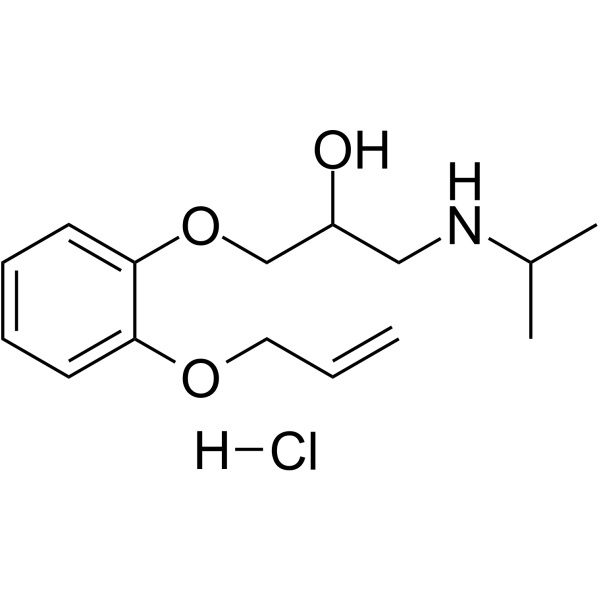
| 规格 | 价格 | 库存 | 数量 |
|---|---|---|---|
| 100mg |
|
||
| 250mg |
|
||
| 500mg |
|
||
| 1g |
|
||
| Other Sizes |
|
| 靶点 |
β-adrenoceptor ( Ki = 7.1 nM )
|
|---|---|
| 体外研究 (In Vitro) |
Oxprenolol 是亲脂性的[3]。 Oxprenolol 在人体腹部皮肤上的渗透率通常为 1.54 ± 1.54×10-3 cm/h[3]。
|
| 体内研究 (In Vivo) |
Oxprenolol (200 mg/kg/天;口腔;每日一次,持续3周)产生有效的β阻滞剂[2]。 动物模型:Wistar品系的雄性大鼠(230至300 g体重)[2]剂量:200 mg/kg 给药方式:口服;每天一次,持续 3 周 结果:该剂量产生有效的 β-阻断作用。
|
| 酶活实验 |
研究了-受体阻滞剂和-受体激动剂与-肾上腺素受体的结合特性,研究了3h -二氢阿普萘洛尔(3H-DHA)与神经氨酸酶处理的大鼠心膜的结合。当膜中总唾液酸含量的60%被去除时,结合试验的再现性比未使用神经氨酸酶处理时好得多,β -肾上腺素能受体的最大密度也增加了。这些数据表明,实验化合物与心肌β -肾上腺素能受体的结合受到细胞膜糖萼唾液酸的影响。经神经氨酸酶处理的膜上的3H-DHA结合位点在心得安检测时显示出严格的立体特异性。拮抗剂或激动剂的抑制作用排序为:dl-propranolol > Oxprenolol > alprenolol > pindolol > YM-09538 > labetalol > acebutolol > atenolol > metoprolol > sotalol > butoxamine > practolol as antagonists or l-isoproterenol > l-epinephrine > l-norepinephrine as agonists。与Bieth等人的正性肌力作用相比,本结合法观察到的Ki值与豚鼠心房中观察到的pA2之间存在良好的相关性(r = 0.91, P < 0.001)。J. Pharmacol. 68, 563-569, 1980),表明本方法可用于筛选新的β -肾上腺素能受体拮抗剂或激动剂。[1]
|
| 动物实验 |
Male rats (230 to 300 g body wt) of the Wistar strain
200 mg/kg Administered orally; daily for 3 weeks |
| 药代性质 (ADME/PK) |
Absorption, Distribution and Excretion
Oral bioavailability is 20-70%. Metabolism / Metabolites Hepatic. Oxoprenolol has known human metabolites that include Oxprenolol glucuronide. Biological Half-Life 1-2 hours |
| 毒性/毒理 (Toxicokinetics/TK) |
71172 women LDLo oral 90 mg/kg BEHAVIORAL: GENERAL ANESTHETIC; CARDIAC: ARRHYTHMIAS (INCLUDING CHANGES IN CONDUCTION); LUNGS, THORAX, OR RESPIRATION: CYANOSIS British Medical Journal., 1(552), 1977
71172 rat LD50 oral 214 mg/kg Arzneimittel-Forschung. Drug Research., 35(1236), 1985 [PMID:2866775] 71172 rat LD50 intraperitoneal 147 mg/kg BEHAVIORAL: SOMNOLENCE (GENERAL DEPRESSED ACTIVITY) Kiso to Rinsho. Clinical Report., 7(3131), 1973 71172 rat LD50 subcutaneous 940 mg/kg BEHAVIORAL: CONVULSIONS OR EFFECT ON SEIZURE THRESHOLD; BEHAVIORAL: ATAXIA; LUNGS, THORAX, OR RESPIRATION: DYSPNEA Arzneimittel-Forschung. Drug Research., 18(164), 1968 [PMID:5695373] 71172 rat LD50 intravenous 33 mg/kg BEHAVIORAL: CONVULSIONS OR EFFECT ON SEIZURE THRESHOLD; BEHAVIORAL: ATAXIA; LUNGS, THORAX, OR RESPIRATION: DYSPNEA Arzneimittel-Forschung. Drug Research., 18(164), 1968 [PMID:5695373] |
| 参考文献 |
|
| 其他信息 |
Oxprenolol Hydrochloride is the hydrochloride salt form of oxprenolol, a lipophilic, nonselective beta-adrenergic receptor antagonist with anti-arrhythmic, anti-anginal and antihypertensive activities. Oxprenolol competitively binds to and blocks beta-1 adrenergic receptors in the heart, thereby decreasing cardiac contractility and rate. This leads to a reduction in cardiac output and lowers blood pressure. In addition, oxprenolol prevents the release of renin, a hormone secreted by the kidneys that causes constriction of blood vessels.
A beta-adrenergic antagonist used in the treatment of hypertension, angina pectoris, arrhythmias, and anxiety. In the present study, as a continuation of a previous one in which two β-blockers celiprolol and bisoprolol were reported (Modamio et al., 1998), transdermal permeation properties across human skin in vitro of propranolol, Oxprenolol, metoprolol and atenolol were compared (including also both celiprolol and bisoprolol), and the potential of each individual drug studied assessed. In addition, correlations between physicochemical parameters of β-blockers chosen, were established, especially lipophilicity expressed as intrinsic partition coefficient, in order to determine whether optimal permeability, and so the predictive potential of these physicochemical parameters can be established. [3] |
| 分子式 |
C15H24CLNO3
|
|---|---|
| 分子量 |
301.81
|
| 精确质量 |
301.144
|
| 元素分析 |
C, 59.69; H, 8.02; Cl, 11.75; N, 4.64; O, 15.90
|
| CAS号 |
6452-73-9
|
| 相关CAS号 |
Oxprenolol-d7 hydrochloride; 1189649-47-5; Oxprenolol; 6452-71-7; Oxprenolol-d7; 1189805-10-4
|
| PubChem CID |
71172
|
| 外观&性状 |
White to off-white solid powder
|
| 沸点 |
403.3ºC at 760 mmHg
|
| 熔点 |
178°C
|
| 闪点 |
197.7ºC
|
| LogP |
3.182
|
| tPSA |
50.72
|
| 氢键供体(HBD)数目 |
3
|
| 氢键受体(HBA)数目 |
4
|
| 可旋转键数目(RBC) |
9
|
| 重原子数目 |
20
|
| 分子复杂度/Complexity |
246
|
| 定义原子立体中心数目 |
0
|
| SMILES |
OC(CNC(C)C)COC1=CC=CC=C1OCC=C.[H]Cl
|
| InChi Key |
COAJXCLTPGGDAJ-UHFFFAOYSA-N
|
| InChi Code |
InChI=1S/C15H23NO3.ClH/c1-4-9-18-14-7-5-6-8-15(14)19-11-13(17)10-16-12(2)3;/h4-8,12-13,16-17H,1,9-11H2,2-3H3;1H
|
| 化学名 |
1-(propan-2-ylamino)-3-(2-prop-2-enoxyphenoxy)propan-2-ol;hydrochloride
|
| 别名 |
Dialicor; Coretal; Oxprenolol hydrochloride; 6452-73-9; Oxprenolol HCl; Evinrozit; Ranidrox; Rixiprol; Trasicor; Secondafil; Oxprenolol hydrochloride
|
| HS Tariff Code |
2934.99.9001
|
| 存储方式 |
Powder -20°C 3 years 4°C 2 years In solvent -80°C 6 months -20°C 1 month 注意: 请将本产品存放在密封且受保护的环境中,避免吸湿/受潮。 |
| 运输条件 |
Room temperature (This product is stable at ambient temperature for a few days during ordinary shipping and time spent in Customs)
|
| 溶解度 (体外实验) |
DMSO: ~250 mg/mL (~828.3 mM)
H2O: ~100 mg/mL (~331.3 mM) |
|---|---|
| 溶解度 (体内实验) |
配方 1 中的溶解度: ≥ 2.08 mg/mL (6.89 mM) (饱和度未知) in 10% DMSO + 40% PEG300 + 5% Tween80 + 45% Saline (这些助溶剂从左到右依次添加,逐一添加), 澄清溶液。
例如,若需制备1 mL的工作液,可将100 μL 20.8 mg/mL澄清DMSO储备液加入400 μL PEG300中,混匀;然后向上述溶液中加入50 μL Tween-80,混匀;加入450 μL生理盐水定容至1 mL。 *生理盐水的制备:将 0.9 g 氯化钠溶解在 100 mL ddH₂O中,得到澄清溶液。 配方 2 中的溶解度: ≥ 2.08 mg/mL (6.89 mM) (饱和度未知) in 10% DMSO + 90% (20% SBE-β-CD in Saline) (这些助溶剂从左到右依次添加,逐一添加), 澄清溶液。 例如,若需制备1 mL的工作液,可将 100 μL 20.8 mg/mL澄清DMSO储备液加入900 μL 20% SBE-β-CD生理盐水溶液中,混匀。 *20% SBE-β-CD 生理盐水溶液的制备(4°C,1 周):将 2 g SBE-β-CD 溶解于 10 mL 生理盐水中,得到澄清溶液。 View More
配方 3 中的溶解度: ≥ 2.08 mg/mL (6.89 mM) (饱和度未知) in 10% DMSO + 90% Corn Oil (这些助溶剂从左到右依次添加,逐一添加), 澄清溶液。 1、请先配制澄清的储备液(如:用DMSO配置50 或 100 mg/mL母液(储备液)); 2、取适量母液,按从左到右的顺序依次添加助溶剂,澄清后再加入下一助溶剂。以 下列配方为例说明 (注意此配方只用于说明,并不一定代表此产品 的实际溶解配方): 10% DMSO → 40% PEG300 → 5% Tween-80 → 45% ddH2O (或 saline); 假设最终工作液的体积为 1 mL, 浓度为5 mg/mL: 取 100 μL 50 mg/mL 的澄清 DMSO 储备液加到 400 μL PEG300 中,混合均匀/澄清;向上述体系中加入50 μL Tween-80,混合均匀/澄清;然后继续加入450 μL ddH2O (或 saline)定容至 1 mL; 3、溶剂前显示的百分比是指该溶剂在最终溶液/工作液中的体积所占比例; 4、 如产品在配制过程中出现沉淀/析出,可通过加热(≤50℃)或超声的方式助溶; 5、为保证最佳实验结果,工作液请现配现用! 6、如不确定怎么将母液配置成体内动物实验的工作液,请查看说明书或联系我们; 7、 以上所有助溶剂都可在 Invivochem.cn网站购买。 |
| 制备储备液 | 1 mg | 5 mg | 10 mg | |
| 1 mM | 3.3133 mL | 16.5667 mL | 33.1334 mL | |
| 5 mM | 0.6627 mL | 3.3133 mL | 6.6267 mL | |
| 10 mM | 0.3313 mL | 1.6567 mL | 3.3133 mL |
1、根据实验需要选择合适的溶剂配制储备液 (母液):对于大多数产品,InvivoChem推荐用DMSO配置母液 (比如:5、10、20mM或者10、20、50 mg/mL浓度),个别水溶性高的产品可直接溶于水。产品在DMSO 、水或其他溶剂中的具体溶解度详见上”溶解度 (体外)”部分;
2、如果您找不到您想要的溶解度信息,或者很难将产品溶解在溶液中,请联系我们;
3、建议使用下列计算器进行相关计算(摩尔浓度计算器、稀释计算器、分子量计算器、重组计算器等);
4、母液配好之后,将其分装到常规用量,并储存在-20°C或-80°C,尽量减少反复冻融循环。
计算结果:
工作液浓度: mg/mL;
DMSO母液配制方法: mg 药物溶于 μL DMSO溶液(母液浓度 mg/mL)。如该浓度超过该批次药物DMSO溶解度,请首先与我们联系。
体内配方配制方法:取 μL DMSO母液,加入 μL PEG300,混匀澄清后加入μL Tween 80,混匀澄清后加入 μL ddH2O,混匀澄清。
(1) 请确保溶液澄清之后,再加入下一种溶剂 (助溶剂) 。可利用涡旋、超声或水浴加热等方法助溶;
(2) 一定要按顺序加入溶剂 (助溶剂) 。